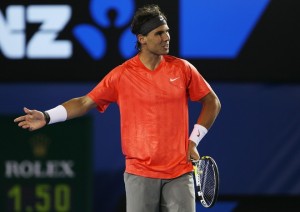It was, at least for me, the shot of the tournament and, since it involved not only running but a very high level of finesse at the end of the run, it’s not surprising that this amazing piece of artistry came from Rafael Nadal.
It was so good I want to deconstruct it for you.
Situation: Marin Cilic serving at deuce, 1-3 in the opening set of their round-of-16 match.
The setup: Cilic’s first serve with Nadal setting up about five feet behind the baseline, nearly both feet inside the extended plane of the deuce side doubles alley.
And now the details: Cilic’s first serve couldn’t be better placed, deep into the corner of the box. Nadal could do no more than stab a backhand return, a shot so desperate that Nadal’s back was to Cilic when he hit that ball.

It skied back, but deep, allowing Nadal to pirouette and race back to the center of the baseline. Cilic stepped inside the baseline near his backhand corner for an inside-out and drove it flat and hard to the extreme left side of Nadal’s court.
Of course Nadal got there, which was a feat in itself, but he could only cross-court the ball back with little on it, leaving Cilic a variety of choices for his killer delivery. He chose a backhand drop shot with a little backspin that dropped just a foot or two beyond the net in upper corner of Nadal’s ad court serving box.
From a dead run that must have covered about 45 feet, Nadal somehow — and maybe only Nadal gets this ball — he ran, demonically, for the dropper. I’ve run and re-run tape of this shot and I’m not exaggerating when I tell you that Nadal got his racket on it no more than two or three inches above the surface of the court. It was a grope, a stretch, just a desperate effort to touch the ball.
Angling his racket face, Nadal tapped a backhand short-angle crosscourt that left Cilic, even with those long arms, no play whatever. Nadal had run so hard, he actually skidded on the hardcourt, his right shoe coming to rest inside the doubles alley after he got the ball.
It’s not as if we haven’t seen Nadal make one of these runs before. There are scores of players fast enough to track down excellent drop shots. But it’s just as much about what you do with the ball when you get to it as it is about the speed to the ball, and that’s where Nadal just blows you away.
I hope you saw it or get a chance to see it.
As you’re probably aware, Nadal went on to win 6-2, 7-5, 6-3 to earn the right to play No. 7 seed and countryman David Ferrer in the quarters. This win was Nadal’s best effort of the Open.
He talked a lot about not sweating as much on court. Well, it was nighttime and cool. But I knew what he meant. He’d contracted a low-level virus that he had to fight through in the early rounds, and it now appears to be gone.
While he took service returns deep behind the baseline, he quickly got inside the base during the rallies and that contributed greatly to his controlling the points. Noticeably absent in his first three matches was domination on serve, but he cranked in 73 percent of his firsts in this match, and finally looked grooved. Zero breaks.
As for Cilic, who reached the Aussie Open semis last year, he might have been a little leg-weary from his four and a half hour, five-set odyssey with (who else?) John Isner a couple nights earlier, though he looked fairly fresh to me.
The bigger issue for Cilic is second serves. He’s got all the other tools. Good movement, strong ground strokes and a big first serve — when he gets it in. But he is generally no better than 53 to 57 percent first serves in, leaving the better returners, like Nadal, chances to break. And Cilic’s second serve is nothing for the top players to fear.
And don’t say you can’t serve big and get a high percentage of firsts in because both Andy Roddick and Isner are consistently up around 65-70 percent.
